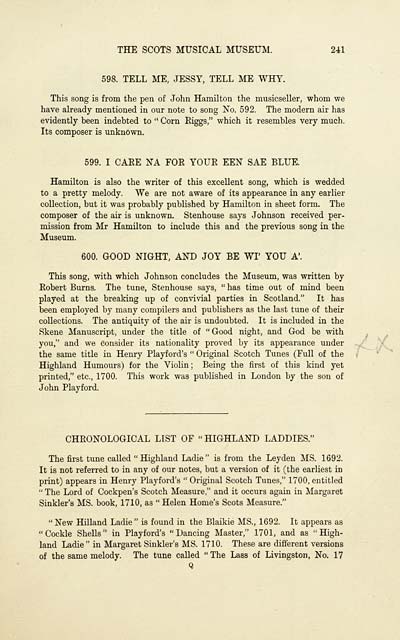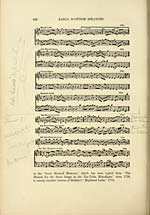Inglis Collection of printed music > Printed text > Early Scottish melodies
(263) Page 241 - Tell me, Jessy, tell me why
Download files
Complete book:
Individual page:
Thumbnail gallery: Grid view | List view

THE SCOTS MUSICAL MUSEUM. 241
598. TELL ME, JESSY, TELL ME WHY.
This song is from the pen of John Hamilton the musicseller, whom we
have already mentioned in our note to song No. 592. The modern air has
evidently been indebted to " Corn Riggs," which it resembles very much.
Its composer is unknown.
599. I CAEE NA FOE YOUR EEN SAE BLUE.
Hamilton is also the writer of this excellent song, which is wedded
to a pretty melody. We are not aware of its appearance in any earlier
collection, but it was probably published by Hamilton in sheet form. The
composer of the air is unknown. Stenhouse says Johnson received per-
mission from Mr Hamilton to include this and the previous song in the
Museum.
600. GOOD NIGHT, AND JOY BE WI' YOU A'.
This song, with which Johnson concludes the Museum, was written by
Robert Burns. The tune, Stenhouse says, " has time out of mind been
played at the breaking up of convivial parties in Scotland." It has
been employed by many compilers and publishers as the last tune of their
collections. The antiquity of the air is undoubted. It is included in the
Skene Manuscript, under the title of " Good night, and God be with
you," and we consider its nationality proved by its appearance under
the same title in Henry Playford's " Original Scotch Tunes (Full of the
Highland Humours) for the Violin; Being the first of this kind yet
printed," etc., 1700. This work was published in London by the son of
John Playford.
CHRONOLOGICAL LIST OF "HIGHLAND LADDIES."
The first tune called "Highland Ladie" is from the Leyden MS. 1692.
It is not referred to in any of our notes, but a version of it (the earliest in
print) appears in Henry Playford's " Original Scotch Tunes," 1700, entitled
" The Lord of Cockpen's Scotch Measure," and it occurs again in Margaret
Sinkler's MS. book, 1710, as " Helen Home's Scots Measure."
"New Hilland Ladie" is found in the Blaikie MS., 1692. It appears as
"Cockle Shells" in Playford's "Dancing Master," 1701, and as "High-
land Ladie" in Margaret Sinkler's MS. 1710. These are different versions
of the same melody. The tune called " The Lass of Livingston, No. 17
598. TELL ME, JESSY, TELL ME WHY.
This song is from the pen of John Hamilton the musicseller, whom we
have already mentioned in our note to song No. 592. The modern air has
evidently been indebted to " Corn Riggs," which it resembles very much.
Its composer is unknown.
599. I CAEE NA FOE YOUR EEN SAE BLUE.
Hamilton is also the writer of this excellent song, which is wedded
to a pretty melody. We are not aware of its appearance in any earlier
collection, but it was probably published by Hamilton in sheet form. The
composer of the air is unknown. Stenhouse says Johnson received per-
mission from Mr Hamilton to include this and the previous song in the
Museum.
600. GOOD NIGHT, AND JOY BE WI' YOU A'.
This song, with which Johnson concludes the Museum, was written by
Robert Burns. The tune, Stenhouse says, " has time out of mind been
played at the breaking up of convivial parties in Scotland." It has
been employed by many compilers and publishers as the last tune of their
collections. The antiquity of the air is undoubted. It is included in the
Skene Manuscript, under the title of " Good night, and God be with
you," and we consider its nationality proved by its appearance under
the same title in Henry Playford's " Original Scotch Tunes (Full of the
Highland Humours) for the Violin; Being the first of this kind yet
printed," etc., 1700. This work was published in London by the son of
John Playford.
CHRONOLOGICAL LIST OF "HIGHLAND LADDIES."
The first tune called "Highland Ladie" is from the Leyden MS. 1692.
It is not referred to in any of our notes, but a version of it (the earliest in
print) appears in Henry Playford's " Original Scotch Tunes," 1700, entitled
" The Lord of Cockpen's Scotch Measure," and it occurs again in Margaret
Sinkler's MS. book, 1710, as " Helen Home's Scots Measure."
"New Hilland Ladie" is found in the Blaikie MS., 1692. It appears as
"Cockle Shells" in Playford's "Dancing Master," 1701, and as "High-
land Ladie" in Margaret Sinkler's MS. 1710. These are different versions
of the same melody. The tune called " The Lass of Livingston, No. 17
Set display mode to: Large image | Transcription
Images and transcriptions on this page, including medium image downloads, may be used under the Creative Commons Attribution 4.0 International Licence unless otherwise stated. ![]()
| Special collections of printed music > Inglis Collection of printed music > Printed text > Early Scottish melodies > (263) Page 241 - Tell me, Jessy, tell me why |
|---|
| Permanent URL | https://digital.nls.uk/94646428 |
|---|---|
| Description | Also: I care na for your een sae blue. Also: Good night, and joy be wi' you a'. |
| Description | Scottish and English songs, military music and keyboard music of the 18th and 19th centuries. These items are from the collection of Alexander Wood Inglis of Glencorse (1854 to 1929). Also includes a few manuscripts, some treatises and other books on the subject. |
|---|
| Description | The Glen Collection and the Inglis Collection represent mainly 18th and 19th century Scottish music, including Scottish songs. The collections of Berlioz and Verdi collected by bibliographer Cecil Hopkinson contain contemporary and later editions of the works of the two composers Berlioz and Verdi. |
|---|

